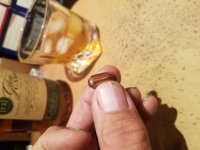There are always questions on what is the correct OAL for a bullet or
if the Data that is being read, is correct for what the person is using.
I just want to start with.........
if your bullet has a "Cannelure Band" on it, 99% of the time this can be the correct OAL for this bullet.
The next thing that I look for is the type of tip or Ogive that the bullet has.
There are Round nose, Flat Nose, Hollow Points and even some look like a Phillips screw driver.
Most of the lighter weigh bullets do not cause a problem in a 9mm case but when you get up in the 147 gr. bullet weight class or heavier, the length of the bullet and the style of it's tip, can be very important in the OAL that you set it at.
For example;
Take the Speer 147 TMJ with a small flat tip and the Berry 147 gr. plated Round Nose bullet.
They both weigh 147 grs but the length of each bullet is very different and the seating depth into the 9mm case not only changes the amount of powder that it will accept but also the pressures of the load per case volume at hand.
The 9mm case, being a tapered case, will also build up pressures as a bullet is seated into it's depths. In the cast of the long Berry 147 RN bullet, it can bottom out and be tight against the brass case before it reaches a seating depth of .30"
Deeper seating will start to deform the case and could cause super high pressures for the shooter.
This will happen in any pistol load, be it 380 or 10mm.
Here is a picture that I have in my loading notes, that might help other loaders understand what is happening as a bullet is being seated and why the OAL in manuals is important, to control pressures and produce safe loads.
Stay safe.

if the Data that is being read, is correct for what the person is using.
I just want to start with.........
if your bullet has a "Cannelure Band" on it, 99% of the time this can be the correct OAL for this bullet.
The next thing that I look for is the type of tip or Ogive that the bullet has.
There are Round nose, Flat Nose, Hollow Points and even some look like a Phillips screw driver.
Most of the lighter weigh bullets do not cause a problem in a 9mm case but when you get up in the 147 gr. bullet weight class or heavier, the length of the bullet and the style of it's tip, can be very important in the OAL that you set it at.
For example;
Take the Speer 147 TMJ with a small flat tip and the Berry 147 gr. plated Round Nose bullet.
They both weigh 147 grs but the length of each bullet is very different and the seating depth into the 9mm case not only changes the amount of powder that it will accept but also the pressures of the load per case volume at hand.
The 9mm case, being a tapered case, will also build up pressures as a bullet is seated into it's depths. In the cast of the long Berry 147 RN bullet, it can bottom out and be tight against the brass case before it reaches a seating depth of .30"
Deeper seating will start to deform the case and could cause super high pressures for the shooter.
This will happen in any pistol load, be it 380 or 10mm.
Here is a picture that I have in my loading notes, that might help other loaders understand what is happening as a bullet is being seated and why the OAL in manuals is important, to control pressures and produce safe loads.
Stay safe.


